陕旅版六年级英语教学计划
- 格式:doc
- 大小:25.00 KB
- 文档页数:2
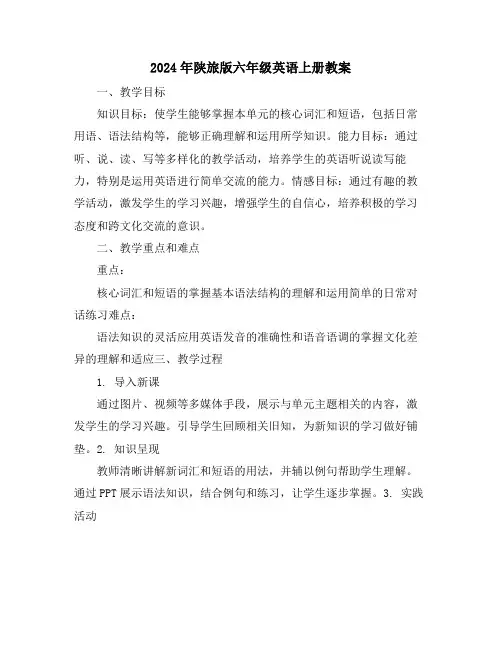
2024年陕旅版六年级英语上册教案一、教学目标知识目标:使学生能够掌握本单元的核心词汇和短语,包括日常用语、语法结构等,能够正确理解和运用所学知识。
能力目标:通过听、说、读、写等多样化的教学活动,培养学生的英语听说读写能力,特别是运用英语进行简单交流的能力。
情感目标:通过有趣的教学活动,激发学生的学习兴趣,增强学生的自信心,培养积极的学习态度和跨文化交流的意识。
二、教学重点和难点重点:核心词汇和短语的掌握基本语法结构的理解和运用简单的日常对话练习难点:语法知识的灵活应用英语发音的准确性和语音语调的掌握文化差异的理解和适应三、教学过程1. 导入新课通过图片、视频等多媒体手段,展示与单元主题相关的内容,激发学生的学习兴趣。
引导学生回顾相关旧知,为新知识的学习做好铺垫。
2. 知识呈现教师清晰讲解新词汇和短语的用法,并辅以例句帮助学生理解。
通过PPT展示语法知识,结合例句和练习,让学生逐步掌握。
3. 实践活动组织学生进行角色扮演,模拟真实场景进行对话练习。
开展小组讨论,鼓励学生围绕单元主题发表观点,提高口语表达能力。
4. 互动探究教师提出问题,引导学生通过合作学习寻找答案,培养学生解决问题的能力。
利用小组合作,共同完成一项与单元主题相关的任务,如制作海报、编写故事等。
5. 总结提升教师总结本课重点知识,强调易错点,帮助学生巩固记忆。
布置适当的课后作业,包括阅读、写作、听力和口语练习,以全面提高学生的英语能力。
四、教学方法和手段直观教学法:利用图片、实物、视频等直观教具,帮助学生建立直观印象,提高记忆效果。
情境教学法:创设真实或模拟的情境,让学生在情境中学习、实践,提高英语应用能力。
任务型教学法:通过设计具体任务,让学生在完成任务的过程中主动探究、合作学习,培养解决问题的能力。
多媒体辅助:充分利用多媒体手段,如PPT、教学软件等,丰富教学内容,提高教学效率。
五、课堂练习、作业与评价方式课堂练习:每节课后设置与当堂内容紧密相关的练习题,以巩固学生所学知识。
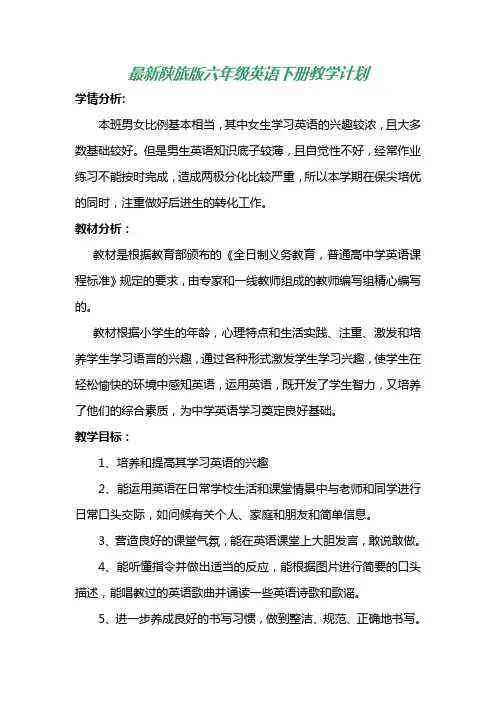
最新陕旅版六年级英语下册教学计划学情分析:本班男女比例基本相当,其中女生学习英语的兴趣较浓,且大多数基础较好。
但是男生英语知识底子较薄,且自觉性不好,经常作业练习不能按时完成,造成两极分化比较严重,所以本学期在保尖培优的同时,注重做好后进生的转化工作。
教材分析:教材是根据教育部颁布的《全日制义务教育,普通高中学英语课程标准》规定的要求,由专家和一线教师组成的教师编写组精心编写的。
教材根据小学生的年龄,心理特点和生活实践、注重、激发和培养学生学习语言的兴趣,通过各种形式激发学生学习兴趣,使学生在轻松愉快的环境中感知英语,运用英语,既开发了学生智力,又培养了他们的综合素质,为中学英语学习奠定良好基础。
教学目标:1、培养和提高其学习英语的兴趣2、能运用英语在日常学校生活和课堂情景中与老师和同学进行日常口头交际,如问候有关个人、家庭和朋友和简单信息。
3、营造良好的课堂气氛,能在英语课堂上大胆发言,敢说敢做。
4、能听懂指令并做出适当的反应,能根据图片进行简要的口头描述,能唱教过的英语歌曲并诵读一些英语诗歌和歌谣。
5、进一步养成良好的书写习惯,做到整洁、规范、正确地书写。
6、进一步养成听英语、读英语和说英语的良好习惯。
教学重点和难点:1、掌握所学“四会”单词、短语。
2、掌握所学句型。
主要措施:1、教学中,采用情景教学法,让学生身临其境,积极主动地参与到课堂教学中去,鼓励学生上课大胆发言,调动学生的非智力因素,提高学生实际运用语言的能力。
2、勤于观察学生掌握知识的情况,及时掌握学生学习英语的情况,课堂上尽可能照顾差生。
每天在上课前的几分钟内,对学生的单词、短语、句子进行抽查,掌握学生的学习情况。
3、通过听、说、读、写、唱、演、画、做等形式,进行大量和语言操练和练习。
4、每天坚持自己检查学生的作业和练习,且坚持在早读时检查学生的单词和课文的背诵。
课时安排:本册教材共八个单元,每单元四课时(即四节四十分钟)进行。
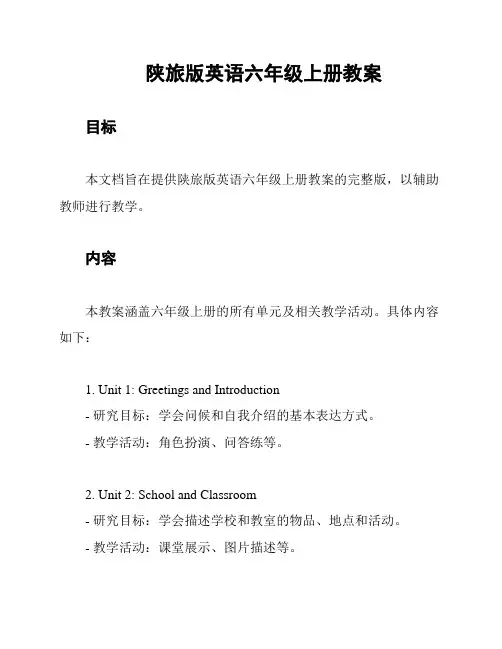
陕旅版英语六年级上册教案目标本文档旨在提供陕旅版英语六年级上册教案的完整版,以辅助教师进行教学。
内容本教案涵盖六年级上册的所有单元及相关教学活动。
具体内容如下:1. Unit 1: Greetings and Introduction- 研究目标:学会问候和自我介绍的基本表达方式。
- 教学活动:角色扮演、问答练等。
2. Unit 2: School and Classroom- 研究目标:学会描述学校和教室的物品、地点和活动。
- 教学活动:课堂展示、图片描述等。
3. Unit 3: Daily Routines- 研究目标:学会描述日常生活中的常见活动。
- 教学活动:小组讨论、填空练等。
4. Unit 4: Family and Friends- 研究目标:学会描述家庭成员和朋友,并表达关系。
- 教学活动:家庭树绘制、口头介绍等。
5. Unit 5: Food and Drinks- 研究目标:学会描述常见食物和饮料。
- 教学活动:看图说话、菜谱设计等。
6. Unit 6: Hobbies and Leisure Activities- 研究目标:学会表达自己的兴趣爱好和休闲活动。
- 教学活动:个人陈述、小组交流等。
7. Unit 7: Around Town- 研究目标:学会描述城市和城市中的建筑和交通方式。
- 教学活动:城市导览、模拟购物等。
8. Unit 8: Nature and Environment- 研究目标:学会描述自然环境和保护环境的重要性。
- 教学活动:实地考察、环保活动策划等。
9. Unit 9: Festivals and Celebrations- 研究目标:学会描述不同的节日和庆祝活动。
- 教学活动:节日展示、文化交流等。
结束语本教案旨在为教师提供完整的教学计划,以帮助六年级学生学习陕旅版英语上册的各个单元内容。
通过多种教学活动的设计,可以提高学生的听、说、读、写的综合能力。
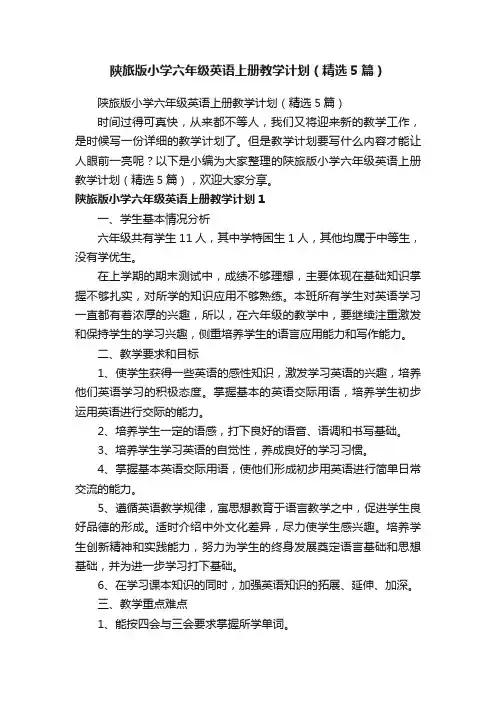
陕旅版小学六年级英语上册教学计划(精选5篇)陕旅版小学六年级英语上册教学计划(精选5篇)时间过得可真快,从来都不等人,我们又将迎来新的教学工作,是时候写一份详细的教学计划了。
但是教学计划要写什么内容才能让人眼前一亮呢?以下是小编为大家整理的陕旅版小学六年级英语上册教学计划(精选5篇),欢迎大家分享。
陕旅版小学六年级英语上册教学计划1一、学生基本情况分析六年级共有学生11人,其中学特困生1人,其他均属于中等生,没有学优生。
在上学期的期末测试中,成绩不够理想,主要体现在基础知识掌握不够扎实,对所学的知识应用不够熟练。
本班所有学生对英语学习一直都有着浓厚的兴趣,所以,在六年级的教学中,要继续注重激发和保持学生的学习兴趣,侧重培养学生的语言应用能力和写作能力。
二、教学要求和目标1、使学生获得一些英语的感性知识,激发学习英语的兴趣,培养他们英语学习的积极态度。
掌握基本的英语交际用语,培养学生初步运用英语进行交际的能力。
2、培养学生一定的语感,打下良好的语音、语调和书写基础。
3、培养学生学习英语的自觉性,养成良好的学习习惯。
4、掌握基本英语交际用语,使他们形成初步用英语进行简单日常交流的能力。
5、遵循英语教学规律,寓思想教育于语言教学之中,促进学生良好品德的形成。
适时介绍中外文化差异,尽力使学生感兴趣。
培养学生创新精神和实践能力,努力为学生的终身发展奠定语言基础和思想基础,并为进一步学习打下基础。
6、在学习课本知识的同时,加强英语知识的拓展、延伸、加深。
三、教学重点难点1、能按四会与三会要求掌握所学单词。
2、能按四会要求掌握所学句型。
3、能在情景中熟练的运用所学的四会句子。
4、能在图片、手势、情景等非语言的提示下,听懂清晰的话语与录音。
5、培养良好的书写习惯,能做到书写整洁、规范。
难点:掌握基本英语交际用语,培养学生对英语的观察、记忆、思维、想象和创造能力。
培养学生预习的习惯,能够把不懂的词标记出来。
在课堂能够认真听讲随时记笔记。
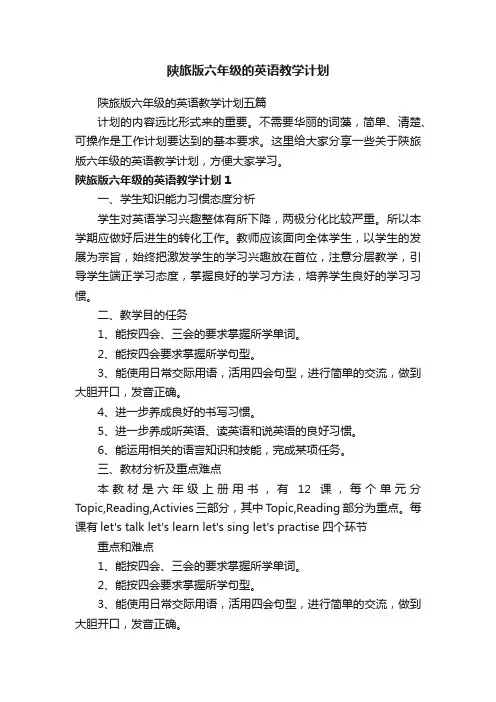
陕旅版六年级的英语教学计划陕旅版六年级的英语教学计划五篇计划的内容远比形式来的重要。
不需要华丽的词藻,简单、清楚、可操作是工作计划要达到的基本要求。
这里给大家分享一些关于陕旅版六年级的英语教学计划,方便大家学习。
陕旅版六年级的英语教学计划1一、学生知识能力习惯态度分析学生对英语学习兴趣整体有所下降,两极分化比较严重。
所以本学期应做好后进生的转化工作。
教师应该面向全体学生,以学生的发展为宗旨,始终把激发学生的学习兴趣放在首位,注意分层教学,引导学生端正学习态度,掌握良好的学习方法,培养学生良好的学习习惯。
二、教学目的任务1、能按四会、三会的要求掌握所学单词。
2、能按四会要求掌握所学句型。
3、能使用日常交际用语,活用四会句型,进行简单的交流,做到大胆开口,发音正确。
4、进一步养成良好的书写习惯。
5、进一步养成听英语、读英语和说英语的良好习惯。
6、能运用相关的语言知识和技能,完成某项任务。
三、教材分析及重点难点本教材是六年级上册用书,有12课,每个单元分Topic,Reading,Activies三部分,其中T opic,Reading部分为重点。
每课有let's talk let's learn let's sing let's practise四个环节重点和难点1、能按四会、三会的要求掌握所学单词。
2、能按四会要求掌握所学句型。
3、能使用日常交际用语,活用四会句型,进行简单的交流,做到大胆开口,发音正确。
4、能在图片、手势、情境等非语言提示的帮助下,听懂清晰的话语和录音。
四、主要措施1、课上认真听,课下努力练每周只有3节英语课,课程安排决定了上课时间,如果不好好利用,不好好学习,要想把知识掌握好那就不太可能。
同时,在课下时间要充分练习。
为此,我准备了各种课外活动,如:利用双休日和课下的时间进行小组活动来学习英语,复习当天或本周所学的知识;每天所学的知识当天检查,用A、B、C来表示优秀、良好、可以填写在教师打出的英语检查表中,以激发学生们竞相学习的热情2、创造英语环境。
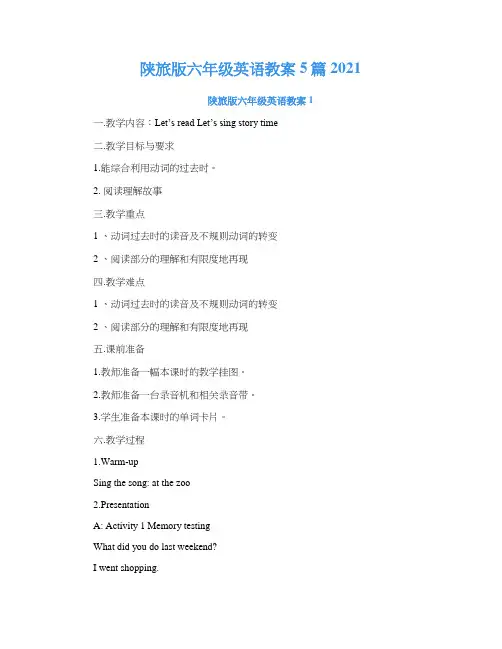
陕旅版六年级英语教案5篇2021陕旅版六年级英语教案1一.教学内容:Let’s read Let’s sing story time二.教学目标与要求1.能综合利用动词的过去时。
2. 阅读理解故事三.教学重点1 、动词过去时的读音及不规则动词的转变2 、阅读部分的理解和有限度地再现四.教学难点1 、动词过去时的读音及不规则动词的转变2 、阅读部分的理解和有限度地再现五.课前准备1.教师准备一幅本课时的教学挂图。
2.教师准备一台录音机和相关录音带。
3.学生准备本课时的单词卡片。
六.教学过程1.Warm-upSing the song: at the zoo2.PresentationA: Activity 1 Memory testingWhat did you do last weekend?I went shopping.I went shopping and visited grandparentsI went shopping and visited grandparents………B: Activity 2 比一比,谁说得最快。
(见表格1)请两个学生上来,背向黑板,教师说出表格中任意一个词组,学生就说出与之对应的词组,败者换其他人,再与胜者比赛,看看全班谁说得最快。
C: Te_t A. 看图跟读课文。
B. 教师提示总结:was / walked / studied / read /went/saw / jumped / swam / returnedD: Activity 3 无字的故事书E: E_ercises(1)Finish the sentences(2)Number the sentencesComprehensive activitystory time1.Two students a group and discuss the story.2.Ask the questions:(1)What did Zoom do on Saturday?(2) What did Zoom do on Sunday?3. Listen and read the story陕旅版六年级英语教案2一.教学内容1.围绕本单元重点词汇和句型进行复习巩固。
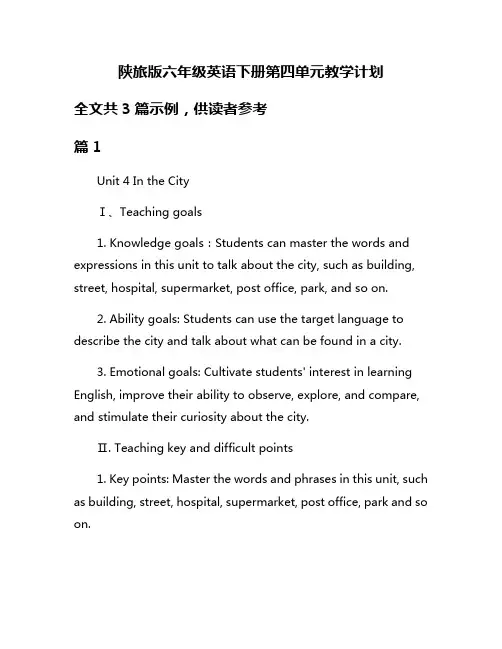
陕旅版六年级英语下册第四单元教学计划全文共3篇示例,供读者参考篇1Unit 4 In the CityⅠ、Teaching goals1. Knowledge goals:Students can master the words and expressions in this unit to talk about the city, such as building, street, hospital, supermarket, post office, park, and so on.2. Ability goals: Students can use the target language to describe the city and talk about what can be found in a city.3. Emotional goals: Cultivate students' interest in learning English, improve their ability to observe, explore, and compare, and stimulate their curiosity about the city.Ⅱ. Teaching key and dif ficult points1. Key points: Master the words and phrases in this unit, such as building, street, hospital, supermarket, post office, park and so on.2. Difficult points: How to use the target language to talk about the city and how to improve students' ability to express themselves.Ⅲ. Teaching methods1. Task-based teaching method. Organize group discussions, pair work, role-play, and other activities to stimulate students' interest in learning and improve their practical English abilities.2. Situational teaching method. Create various city scenes for students to experience and interact in the classroom.Ⅳ. Teaching aids1. PPT courseware, pictures of the city, maps, and other scene-setting aids.2. Classroom decorations to simulate a city environment.Ⅴ. Teaching procedures1. Warm-up (10 minutes)Show pictures of different city landmarks and ask students to guess the names.Ask students to describe what they see in the picture.2. Presentation (15 minutes)Introduce new words such as building, street, hospital, supermarket, post office, park, etc.Teach students how to use these words in sentences.3. Practice (20 minutes)Divide students into groups and let them discuss the question "What can you find in a city?"Each group will then present their findings to the class.4. Consolidation (15 minutes)Play a game of "City Scavenger Hunt" where students have to find different landmarks in the classroom or school.5. Homework assignment (5 minutes)Ask students to write a short paragraph describing their favorite place in the city and what can be found there.Ⅵ. Blackboard design1. Key words: building, street, hospital, supermarket, post office, park2. Target sentence: What can you find in a city?Ⅶ. After class reflectionEvaluate the effectiveness of the teaching process by observing students' participation, understanding, and pronunciation of new words. Make adjustments accordingly for future lessons.篇2陕旅版六年级英语下册第四单元教学计划Unit 4: Making a DifferenceObjectives:1. To introduce and be able to use vocabulary related to making a difference2. To understand and be able to talk about ways to make a positive impact in the community3. To practice reading and writing skills through guided activities4. To develop communication skills through group discussions and presentationsWeek 1:Day 1:- Warm-up activity: Review vocabulary from previous units related to community and giving back- Introduction to new vocabulary: charity, donation, volunteer, fundraising- Pair work: Practice using new vocabulary in sentences- Homework: Write a short paragraph about a time when you helped someone in needDay 2:- Reading comprehension: Read a short passage about a charity event and answer questions- Group discussion: Discuss ways to raise money for a charity in your community- Role play: Act out a conversation between a volunteer and someone interested in donating- Homework: Research a charity organization in your community and write a brief report about their workWeek 2:Day 1:- Vocabulary review: Flashcards and matching game with new words- Writing activity: Write a letter to a charity organization expressing interest in volunteering- Peer editing: Review and make suggestions on classmates' letters- Homework: Practice spelling and pronunciation of new vocabulary wordsDay 2:- Listening activity: Listen to a recording of a fundraising event and fill in missing information- Creative writing: Write a story about a character who made a difference in their community- Group presentation: Share stories and discuss ways to inspire others to get involved- Homework: Prepare a short presentation about a cause you care about and how others can helpAssessment:- Quizzes on vocabulary and reading comprehension- Participation in group discussions and presentations- Writing assignments including letters and reports- Overall engagement and understanding of unit objectivesBy the end of this unit, students should have a better understanding of how they can make a positive impact in their community and be inspired to get involved in charitable work. This unit aims to develop not only English language skills but also a sense of empathy and social responsibility among students.篇3Teaching Plan for Grade Six English, Unit FourI. Objectives:1. Students will be able to identify and use new vocabulary related to transportation.2. Students will be able to ask for and give directions using prepositions of place.3. Students will be able to write simple sentences describing locations and directions.II. Materials:1. Textbook: Shanglv Edition Grade 6 English, Unit 42. Flashcards with pictures of different modes of transportation3. Whiteboard and markers4. Worksheets with exercises related to vocabulary and directionsIII. Activities:1. Warm-up (10 minutes)- Review previous lessons on transportation vocabulary- Play a game of "I Spy" with transportation objects in the classroom- Sing a song related to transportation2. Introduction of New Vocabulary (15 minutes)- Introduce new vocabulary related to transportation: car, bus, train, bicycle, plane, boat- Use flashcards and pictures to help students remember the words- Practice pronunciation and spelling of the new vocabulary3. Practice Asking for and Giving Directions (20 minutes)- Review prepositions of place: next to, behind, in front of, between, on, under- Model and practice asking for and giving directions using the new vocabulary (e.g. "Where is the bus station?" "The bus station is next to the library.")- Provide scenarios for students to practice giving directions to a partner4. Writing Exercise (15 minutes)- Distribute worksheets with blank maps and ask students to write sentences describing locations and directions (e.g. "The post office is between the bank and the supermarket.")- Monitor students as they work and provide feedback on their writing5. Speaking Activity (20 minutes)- Divide students into pairs and give each pair a map with locations marked- Ask students to take turns giving directions to each other using the vocabulary and prepositions they have learned- Encourage students to use complete sentences and ask for clarification when needed6. Review and Assessment (10 minutes)- Review key vocabulary and phrases from the lesson- Ask students to summarize what they have learned about transportation and giving directions- Administer a short quiz to assess students' understanding of the material covered in the lessonIV. Homework:- Assign students a writing task to describe the location of their school and give directions from their home to school using the vocabulary and prepositions learned in class.Overall, this lesson plan is designed to engage students in actively using the new vocabulary and grammar structures in practical contexts. By combining speaking, writing, and listening activities, students will have multiple opportunities to practice and reinforce their language skills related to transportation and giving directions.。
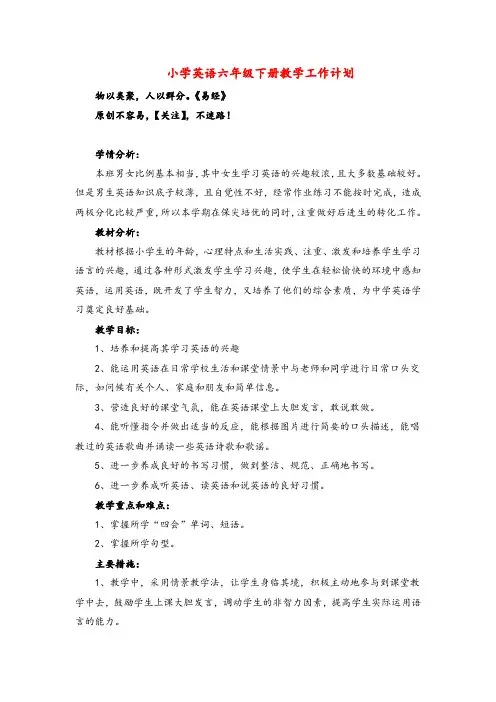
小学英语六年级下册教学工作计划物以类聚,人以群分。
《易经》原创不容易,【关注】,不迷路!学情分析:本班男女比例基本相当,其中女生学习英语的兴趣较浓,且大多数基础较好。
但是男生英语知识底子较薄,且自觉性不好,经常作业练习不能按时完成,造成两极分化比较严重,所以本学期在保尖培优的同时,注重做好后进生的转化工作。
教材分析:教材根据小学生的年龄,心理特点和生活实践、注重、激发和培养学生学习语言的兴趣,通过各种形式激发学生学习兴趣,使学生在轻松愉快的环境中感知英语,运用英语,既开发了学生智力,又培养了他们的综合素质,为中学英语学习奠定良好基础。
教学目标:1、培养和提高其学习英语的兴趣2、能运用英语在日常学校生活和课堂情景中与老师和同学进行日常口头交际,如问候有关个人、家庭和朋友和简单信息。
3、营造良好的课堂气氛,能在英语课堂上大胆发言,敢说敢做。
4、能听懂指令并做出适当的反应,能根据图片进行简要的口头描述,能唱教过的英语歌曲并诵读一些英语诗歌和歌谣。
5、进一步养成良好的书写习惯,做到整洁、规范、正确地书写。
6、进一步养成听英语、读英语和说英语的良好习惯。
教学重点和难点:1、掌握所学“四会”单词、短语。
2、掌握所学句型。
主要措施:1、教学中,采用情景教学法,让学生身临其境,积极主动地参与到课堂教学中去,鼓励学生上课大胆发言,调动学生的非智力因素,提高学生实际运用语言的能力。
2、勤于观察学生掌握知识的情况,及时掌握学生学习英语的情况,课堂上尽可能照顾差生。
每天在上课前的几分钟内,对学生的单词、短语、句子进行抽查,掌握学生的学习情况。
3、通过听、说、读、写、唱、演、画、做等形式,进行大量和语言操练和练习。
4、每天坚持自己检查学生的作业和练习,且坚持在早读时检查学生的单词和课文的背诵。
课时安排:本册教材共八个单元,每单元四课时(即四节四十分钟)进行。
【素材积累】每个人对未来都有所希望和计划,立志是成功的起点,有了壮志和不懈的努力,就能向成功迈进。
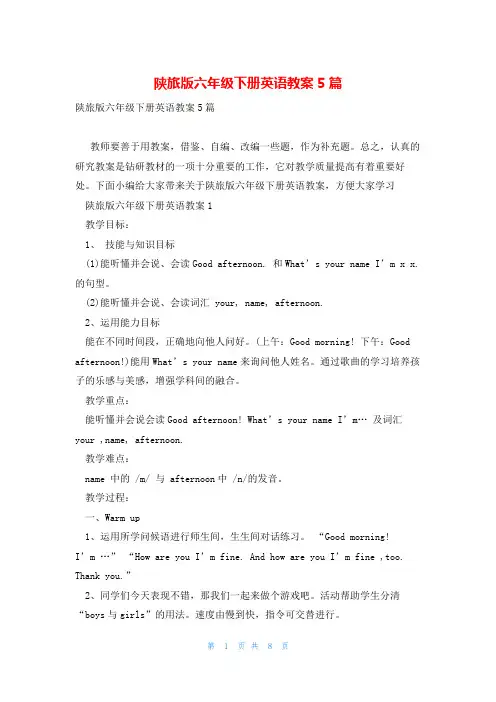
陕旅版六年级下册英语教案5篇陕旅版六年级下册英语教案5篇教师要善于用教案,借鉴、自编、改编一些题,作为补充题。
总之,认真的研究教案是钻研教材的一项十分重要的工作,它对教学质量提高有着重要好处。
下面小编给大家带来关于陕旅版六年级下册英语教案,方便大家学习陕旅版六年级下册英语教案1教学目标:1、技能与知识目标(1)能听懂并会说、会读Good afternoon. 和What’s your name I’m x x.的句型。
(2)能听懂并会说、会读词汇 your, name, afternoon.2、运用能力目标能在不同时间段,正确地向他人问好。
(上午:Good morning! 下午:Good afternoon!)能用What’s your name来询问他人姓名。
通过歌曲的学习培养孩子的乐感与美感,增强学科间的融合。
教学重点:能听懂并会说会读Good afternoon! What’s your name I’m… 及词汇your ,name, afternoon.教学难点:name 中的 /m/ 与 afternoon中 /n/的发音。
教学过程:一、Warm up1、运用所学问候语进行师生间,生生间对话练习。
“Good morning!I’m …” “How are you I’m fine. And how are you I’m fine ,too. Thank you.”2、同学们今天表现不错,那我们一起来做个游戏吧。
活动帮助学生分清“boys与girls”的用法。
速度由慢到快,指令可交替进行。
二、Lead inOK!boys and girls ,you’ve done a good job. Look!老师左右手各持一手偶,通过变换音调来演一段对话,引出本课重点:What’s your name 手偶1:Hi, I’m Mr.Li . What’s your name 手偶2: Hello, I’m Sam.三、Text teaching1、同学们现在我是Mr.Li不是Ms.Liu,老师说话的声音变粗。
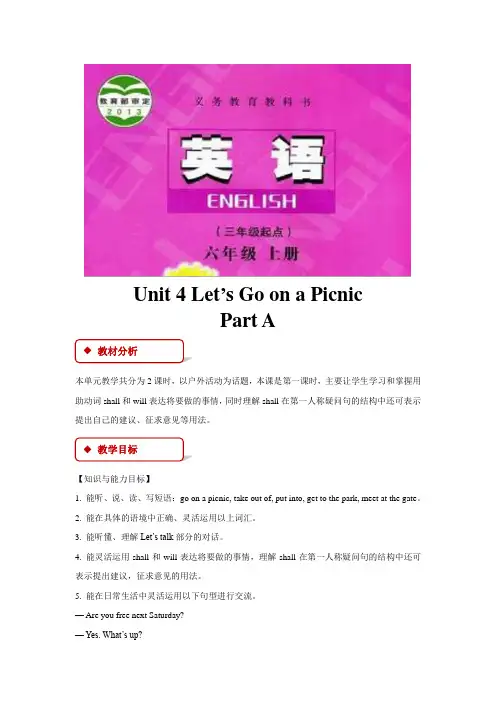
Unit 4 Let ’s Go on a PicnicPart A本单元教学共分为2课时,以户外活动为话题,本课是第一课时,主要让学生学习和掌握用助动词shall 和will 表达将要做的事情,同时理解shall 在第一人称疑问句的结构中还可表示提出自己的建议、征求意见等用法。
【知识与能力目标】1. 能听、说、读、写短语:go on a picnic, take out of, put into, get to the park, meet at the gate 。
2. 能在具体的语境中正确、灵活运用以上词汇。
3. 能听懂、理解Let’s talk 部分的对话。
4. 能灵活运用shall 和will 表达将要做的事情,理解shall 在第一人称疑问句的结构中还可表示提出建议,征求意见的用法。
5. 能在日常生活中灵活运用以下句型进行交流。
— Are you free next Saturday?— Yes. What’s up?What shall we take?Shall we meet at the gate of the park?When shall we meet, 8:00 or 8:30?【过程与方法目标】引导学生问完成Let’s learn,理解L et’s talk的对话内容。
【情感态度价值观目标】1. 在制订和实施活动方案中增强互助和分享的意识。
2. 培养学生的阅读理解能力和语言知识的综合运用能力。
【教学重点】1. 能听、说、读、写短语:go on a picnic, take out of, put into, get to the park, meet at the gate。
2. 能听懂、理解Let’s talk部分的对话。
【教学难点】1. 能灵活运用shall和will表达将要做的事情,理解shall在第一人称疑问句的结构中还可表示提出建议,征求意见的用法。
2. 能在日常生活中灵活运用以下句型进行交流。
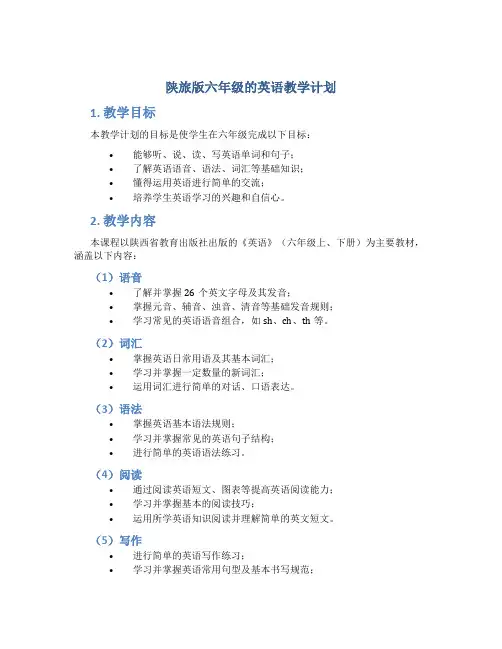
陕旅版六年级的英语教学计划1. 教学目标本教学计划的目标是使学生在六年级完成以下目标:•能够听、说、读、写英语单词和句子;•了解英语语音、语法、词汇等基础知识;•懂得运用英语进行简单的交流;•培养学生英语学习的兴趣和自信心。
2. 教学内容本课程以陕西省教育出版社出版的《英语》(六年级上、下册)为主要教材,涵盖以下内容:(1)语音•了解并掌握26个英文字母及其发音;•掌握元音、辅音、浊音、清音等基础发音规则;•学习常见的英语语音组合,如sh、ch、th等。
(2)词汇•掌握英语日常用语及其基本词汇;•学习并掌握一定数量的新词汇;•运用词汇进行简单的对话、口语表达。
(3)语法•掌握英语基本语法规则;•学习并掌握常见的英语句子结构;•进行简单的英语语法练习。
(4)阅读•通过阅读英语短文、图表等提高英语阅读能力;•学习并掌握基本的阅读技巧;•运用所学英语知识阅读并理解简单的英文短文。
(5)写作•进行简单的英语写作练习;•学习并掌握英语常用句型及基本书写规范;•进行概括、补充句子的写作练习。
3. 教学方法教学方法主要采用以下方式:(1)听力训练开展听力练习,帮助学生听懂英语单词、句子和段落,增强语感和语音能力。
(2)多媒体辅助教学通过多媒体课件、视频、音频等辅助教学方式,让学生更好地了解英语语音、语法和词汇。
(3)交互式教学采用组内讨论、角色扮演等方式,让学生在真实语境下运用英语,增强交际能力。
(4)个性化教学根据学生的个性和英语水平,采用不同的教学方式和方法,提高英语教学的适应性和针对性。
4. 教学评估针对学生的英语听、说、读、写等方面,进行定期考试和小测试,并对学生的学习情况进行评估和反馈。
教师还将针对学生的表现制定不同的教学计划和教学辅导方案。
5. 其他说明为保证教学质量,教师还将定期组织家长会,介绍学生的学习情况和教学计划,与家长沟通交流,共同促进学生的英语学习。
同时,教师还将定期参加教研活动和培训,不断提高教学水平和教育教学质量。
陕旅版六年级的英语教学计划陕旅版六年级英语教学计划一、教学目标1. 通过本课程的学习,学生能够更好地掌握英语的基本词汇、语法和语音知识。
2. 学生能够在口语和听力方面表达自己的观点和想法。
3. 提高学生的阅读水平,使其能够理解英语文章和故事。
4. 培养学生的英语学习兴趣和自信心。
二、教学内容本课程的主要内容包括基本词汇、语法和语音知识的学习,口语和听力训练以及阅读理解。
以下是具体的教学内容:1. 基本词汇:学习常用词汇的发音和用法。
2. 语法:学习简单的句子结构和时态。
3. 语音:学习英语语音的基本知识和发音规则。
4. 口语和听力训练:训练学生的口语和听力能力,使其能够自如地表达自己的观点和想法。
5. 阅读理解:练习阅读英语文章和故事,提高学生的阅读水平。
三、教学方法1. 情景模拟法:通过模拟实际情景,培养学生的口语表达能力。
2. 任务型教学法:通过完成实际任务,激发学生学习的兴趣。
3. 合作学习法:培养学生合作学习的能力,促进他们之间的相互交流和合作。
4. 讨论法:通过讨论的方式,促进学生主动思考,提高其思维能力。
5. 游戏教学法:通过有趣的游戏,激发学生的学习兴趣,提高其学习积极性。
四、教学进度第一周:1. Greeting and Introduce Yourself2. Learn the Alphabet and Phonics Sounds3. Numbers第二周:1. What's Your Name?2. How are you?3. Days of the Week and months of the Year第三周:1. Colours2. Shapes3. Numbers第四周:1. Countries and Nationalities2. Food and Drink3. Ordering food and Drinks第五周:1. Sports2. Hobbies3. Simple present tense第六周:1. Animals2. Family3. Household Items第七周:1. Clothes2. Weather3. Modal verbs第八周:1. Directions and Locations2. Common Phrases for Travel3. Prepositions of Place第九周:1. At the airport2. Checking In and Boarding3. Simple Past Tense第十周:1. At the Hotel2. Room Reservations3. Describing Accommodations第十一周:1. Tourist Attractions2. Preparing for a Trip3. Reviewing Grammar and Vocabulary五、教学评估学生的学习表现将通过课堂参与、提问回答、考试、作业等方式进行评估。
六年级上册版英语教案陕旅版5篇教学中,备课是一个必不行少、非常重要的环节,备课不充分或者备得不好,会紧要影响课堂的气氛和学生的踊跃性,一堂打算充分的课,会令学生和教师都获益非浅。
因此,平常,我紧抓备、教、改、辅、查等教学中的重要环节。
以下是我带来的六年级上册最新版英语教案陕旅版内容,感谢您的阅读,盼望能协助到您!六年级上册最新版英语教案陕旅版1my home教材分析:本课时主要是通过展示家庭居室构造,让学生学习各个房间的英文名称study, bathroom, bedroom, living room,kitchen. 家是每个学生最熟识的地方,学生要学会运用本课所学学问来简洁描述自己的家,结合学过的语言描述各个房间。
“Lets do”局部的教学是结合“Letslearn”中所学过的单词进展扩展,让学生知道一些相关单词的指示用语。
让学生在听懂这些用语的根底上,进展效仿和听、做活动。
还可设计多种课堂活动,使学生驾驭这一局部的内容,同时激发学生学习英语的爱好。
教学目标:1.能简洁描述自己的房间。
2.能听、说、认读本课主要单词:study, bathroom, bedroom, living room,kitchen,并能在日常生活中运用。
3.能听懂Lets do中的指示语,并遵照指令作出相应的动作。
教学重点:1、听、说、认读单词:study, bathroom, living room, bedroom, kitchen。
2、学习表示指令的词组。
教学难点:单词study, bathroom, bedroom的发音。
教学方法:引导法启发法直观教学法学法分析:小组合作学习法探讨学习法自主学习法教学过程:1 Warm-up/Revision老师引导1、集体唱英文儿歌。
2、复习上节课所学单词2 Presentation1、出示study 的图片,手指着书房里的书问学生:What are they? 教读单词study, 并板书。
六年级英语下册教学计划通过一学期的教学,大多数学生英语学习有进步,英语字写得漂亮了,学习态度有所好转,上学期通过采用边学习新知识和复习旧知识相结合的方法,他们的学习有所进步。
但是因为新旧教材衔接问题,学生学习这套教材有一定难度。
一、教材分析:本教材注重学生审美感受和语言能力的培养,强调学生创新意识和实践能力的协调发展,以“接近社会、贴近学生、学以致用”为原则,选择符合六年级小学生身心特点的教学内容设计课题。
全册共有10个单元,内容涵盖打电话,方位表达,长相描述,个人梦想等,分配在各课之中。
教材特点:1.强调语言运用2.注重能力培养3.突出兴趣激发4.重视双向交流5.融合学科内容6.重视灵活扩展7.实现语言发展8.提供多媒体的配套材料。
二、针对情况采取的措施:针对学生的具体情况,我将采取以下措施:1,注重情景教学,创设英语环境,营造学习气氛,使学生有更多的机会接触英语,感触英语,应用英语。
2,结合学生的年龄特点,结合教学内容,设计适合六年级学生的课堂教学活动,调动学生的学习积极性。
3.针对学生记,背单词难这一问题,教授学生形象法记单词的主要方法和要领,并时常训练强化,使之形成习惯。
4.对学生进行语音知识训练,教授国际音标,让学生从简单机械地模仿式学习,过渡到有正确的语音知识知指导英语学习的阶段,也为自学铺路。
5,加强阅读训练和语法知识的渗透学习。
6,渗透英语背景知识的学习,使学生扩大视野,了解国外的风土人情,异国文化,习俗等,进一步了解英语,运用英语。
7,进一步加强毕业班学生的思想工作,做好小学毕业与中学的衔接工作。
三、总体教学目标:1,坚持快乐英语教学法,调动学生学习英语的积极性。
2,巧用英文儿歌、歌谣、绕口令、谚语等训练学生的语音、语调。
3,引导学生运用观察、发现、归纳、实践等方法学习语言知识,感悟语言功能。
4,在训练学生听说能力的同时,加强读写训练。
5,结合学生实际,适当讲解语法知识,做一些练习题和试卷,做好小学升中学的准备工作.四、教学进度计划本学期,共有十个单元(八个教学单元、两个复习单元),每单元预计用六课时。
陕旅版六年级英语上册教学计划Analysis of Teaching Plan for Shaanxi n Grade 6 XXXI。
Analysis of Student XXXOverall。
Grade 6 students have a decreased interest in learning English and there is a XXX。
this semester。
XXX' interest in learning English。
XXX learning。
and help them XXX to learn English。
We also want to help students develop a certain sense of language and a good XXX。
XXX。
XXX。
we want to help them XXX in English。
At the same time。
we want to cultivate students' n。
memory。
thinking。
n。
XXX use of language。
pay n to the development of students' abilities。
XXX of students' interest in learning。
and value the flexible n of knowledge。
We want to truly achieve the goals of English teaching。
Based on the dialogues in Grade 5.we have added reading content and difficulty。
The use of personal pronouns。
verb changes。
and n verbs in the present tense。
陕旅六年级英语下册教案3篇陕旅六年级英语下册教案篇1教学内容:1.词汇(1)复习关于职业的词汇:doctor, teacher, nurse, cook, fireman, driver, policeman, pilot, singer.(2)学习生词:astronaut, coach, actor (actress),writer.2.功能句型(1)复习询问他人职业及回答:What does he/she do? He/She is a/an …。
(2)学习询问对方将来想要从事的工作及回答:What do you want to be when you grow up?I want to be a/an …。
教学目标:1.知识目标(1)能掌握和职业相关的一些词汇,并能在相应的功能句型中熟练运用;(2)能在恰当的情景下熟练运用关于询问他人的职业及回答的交际用语;(3)能在相应的情景下熟练地运用关于询问对方将来想要从事的工作及回答的交际用语。
2.能力目标(1)通过学习和操练,使学生能掌握本课所学关于职业的词汇,能熟练询问他人的职业及对将来工作的理想,并做出相应的回答;(2)在学习过程中培养学生发现问题和解决问题的能力,提高自学能力;3.策略目标(1)帮助学生学会与人合作,共同完成学习任务;(2)帮助学生学会观察生活中标的英语,学会借助词典来学习。
4.其他目标(1)在学习职业名称的过程中了解“感动中国的2021年度人物”,潜移默化地为学生树立榜样;(2)在小组学习和帮助他人学习的同时,培养学生乐于助人,热爱集体的良好品质;(3)通过多种形式的游戏和活动,激发学生英语学习兴趣。
教学重点:1.重点词汇:astronaut, coach, actor (actress), writer.2.重点句型:What do you want to be? I want to bea/an …。
教学难点:1.正确朗读和运用关于职业的词汇。
陕旅版六年级英语上册教学计划(及进度表)一、指导思想:陕旅版六年级英语教材,是基础教育阶段英语课程强调的从学生的兴趣、生活经验和认知水平出发,倡导体验、实践、参与、合作与交流的学习方式和任务型的教学途径,发展学生综合语言运用能力,使语言学习的过程成为学生形成积极的学习态度。
二、学情分析:本学期我担任六年级的英语课,学生年龄在11--12岁之间,他们身心健康、活泼可爱、接受知识的能力强;大多数的同学对英语很感兴趣,学习积极性高。
因此在本学期的教学中,要注重学习兴趣的培养,注意因材施教,搞好优生优培和困难生的辅导和转化工作,形成比、学、赶、帮、超的浓厚的学习氛围,提高教学成绩和教育教学质量。
三、教材分析:本教材共8个单元。
根据小学生的年龄,心理特点和生活实践,教材的编写注重激发和培养学生学习语言的兴趣,通过形式多样的话题,丰富多彩的语境活动,活泼有趣的儿歌,让同学在听说读写玩演唱的过程中轻松愉快的感知英语,学习英语,达到掌握英语,运用英语的目的。
四、教学重点难点:重点:1.本册所有的词汇。
2.重点句型:It’ s time to ….Care for ….Let’s ….It was here just now .What did you do last weekend ?I had a good time.难点:1、语音教学。
2、所有词汇的读写。
3、句型:It’s time to ….Let’s ….It was here just now .What did you do last weekend ?I had a good time.五、教学目标:1、能听、说、读、写词汇:2、通过趣味课堂活动,激发学生学习英语的兴趣。
3、能正确使用It’s time to …. 结构的句型,就该干某事的时候了进行问答,并掌握一般疑问句Can I …? Yes/No…4、能够正确模仿Let’s talk 中的对话,做到语音语调自然。
2016—2017学年度第一学期六年级上册
英语教学计划
谢佳利
新的学期已经来临,为了使教学工作顺利开展,特制定如下计划:
一、学情分析
本班学生学习英语两极分化比较严重,所以本学期应做好后进生的转化工作。
教师面向学生,以学生的发展为宗旨,始终把激发学生的学习兴趣放在首位注意分层教学,引导学生端正学习态度,掌握良好的学习方法,培养学生良好的学习习惯。
二、教材分析
本册教材内容在前面两年的基础上,继续选择紧密联系学生的生活和学习实际,选择了切合学生需求的话题,八个单元依次涉及了表达时间安排、家务劳动、饮食、餐具、问路、购物、人物特征、国籍。
这些语言材料真实地道、活泼有趣,使学生在学中乐,乐于学。
教材的教学形式丰富多样,其中包括对话、歌谣、歌曲、绕口令、任务、绘画、剪贴等,使学生能够在丰富多彩、生动有趣的课堂氛围中学习语言运用语言。
三、教学目标
1、形成学习英语的兴趣和爱好,在动态真实的环境中使用英语进行活动的积极性。
2、能运用英语在日常学校生活和课堂情景中与老师和同学进行日常口头交际,如问候有关个人、家庭和朋友和简单信息。
3、能参加运用英语组织和开展日常课堂教学和生活游戏及其它课内外活动。
4、能听懂指令并做出适当的反应,能根据图片进行简要的口头描述,能唱教过的英语歌曲并诵读一些英语诗歌和歌谣。
5、乐于了解英语国家儿童的兴趣和爱好及外国人的风俗习惯。
6、进一步养成良好的书写习惯。
7、进一步养成听英语、读英语和说英语的良好习惯。
四、教学重点和难点
1、要求掌握所学单词、短语。
2、掌握所学句型。
3、使用常交际用语,活用四会句型,进行简单的交流,做到大胆开口,发音正确。
4、在任务型学习的过程中运用相关的语言知识和技能,完成某项任务。
5、进一步培养良好的书写习惯,能做到书写整洁、规范。
五、具体措施:
1、教学中,采用情景教学法,让学生身临其境,积极主动地参与到课堂教学中去,调动学生的非智力因素,提高学生实际运用语言的能力。
2、通过听、说、读、写、唱、游、演、画、做等形式,进行大量和语言操练和练习。
教学进度安排表
(范文素材和资料部分来自网络,供参考。
可复制、编制,期待你的好评与关注)。